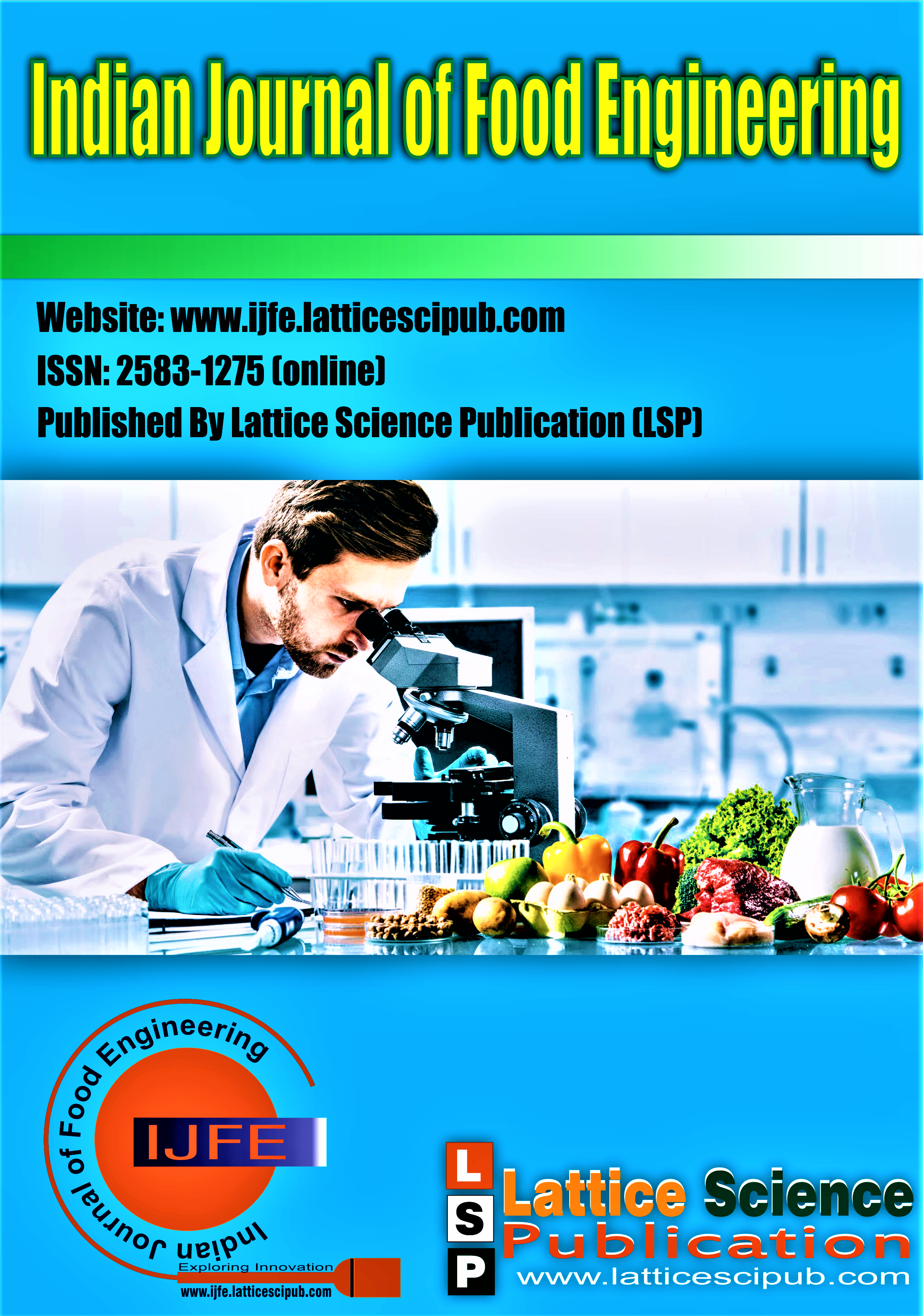Boosting Nutritional Benefits: Ultrasonic Treatment of Flax and Pumpkin Seeds for Developing Fortified Mushroom Sprinkle Powder
Main Article Content
Abstract
This study evaluated the physicochemical properties and sensory acceptability of fortified mushroom sprinkle powder formulated with blends of Agaricus bisporus, ground chia powder, ultrasonic-treated flaxseed powder, and ground pumpkin seeds. Standard analytical methods and Pearson's correlations were employed to analyse blends with varying mushroom flour concentrations (10%, 15%, 20%, 25%, and 30%). Results indicated that increasing mushroom content enhanced protein, ash, fibre, zinc, and iron levels in both composite flours and fortified smoothies. Additionally, in vitro protein digestibility of the smoothies improved with higher mushroom incorporation. The inclusion of Pleurotus ostreatus flour increased pH and decreased total titratable acidity (TTA), while A. bisporus flour exhibited the reverse effect. Elevated mushroom content also led to reductions in fat, carbohydrates, energy, and viscosity in the fortified flours and smoothies. Positive linear effects were observed for functional properties such as foaming capacity, foam stability, fat absorption, water retention, water absorption, solubility index, and swelling capacity, whereas compact density, bulk density, and syneresis decreased linearly. Gelation capacity, emulsifying activity, and emulsion stability were unaffected by P. ostreatus but showed slight decreases with A. bisporus. This study underscores the potential of mushroom flours as a valuable food fortification ingredient, offering enhanced nutritional profiles and various healthpromoting benefits (R.M. Ishara Jackson1, Daniel N. Sila2, Glaston M. Kenji) (2018) [10].
Downloads
Article Details

This work is licensed under a Creative Commons Attribution-NonCommercial-NoDerivatives 4.0 International License.
How to Cite
References
Chang, S.T.; Miles, P.G. Mushrooms: Cultivation, Nutritional Value, Medicinal Effect, and Environmental Impact, 2nd ed.; CRC Press: Boca Raton, FL, USA, 2008. DOI: https://doi.org/10.1201/9780203492086
Ergönül, P.G.; Akata, I.; Kalyoncu, F.; Ergönül, B. Fatty acid compositions of six wild edible mushroom species. Sci. World J. 2013, 2013, 163964. DOI: https://doi.org/10.1155/2013/163964
Guillamón, E.; García-Lafuente, A.; Lozano, M.; D’Arrigo, M.; Rostagno, M.A.; Villares, A.; Martínez, J.A. Edible mushrooms: Role in the prevention of cardiovascular diseases. Fitoterapia, 81, 715–723. DOI: https://doi.org/10.1016/j.fitote.2010.06.005
Longvah, T.; Deosthale, Y.G. Composition and nutritional studies on edible wild mushroom from Northeast India. Food Chem. 1998, 63, 331–334. DOI: https://doi.org/10.1016/S0308-8146(98)00026-0
Mattila, P.; Konko, K.; Euvola, M.; Pihlava, J.; Astola, J.; Vahteristo, L. Contents of vitamins, mineral elements and some phenolic compound in cultivated mushrooms. J. Agric. Food Chem. 2001, 42, 2449–2453. DOI: https://doi.org/10.1021/jf001525d
Bano, Z.; Rajarathnam, S. Pleurotus mushrooms. Part II. Chemical composition, nutritional value, post-harvest physiology, preservation, and role as human food. Crit. Rev. Food Sci. Nutr. 1988, 27, 87–158. [CrossRef] J. Fungi 2021, 7, 427 14 of 18. DOI: https://doi.org/10.1080/12298093.2020.1835142
Stamets, P. (2005). Notes on nutritional properties of culinary-medicinal mushrooms. I. J. of Medicinal Mushrooms. 7: 103-110. DOI: https://doi.org/10.1615/IntJMedMushr.v7.i12.100
Manzi, P.S., Marconi, A. A., Pizzoferrato, L. (2004). Commercial mushroom nutritional quality and effect of cooking. Food Chem. 84: 201-206. DOI: https://doi.org/10.1016/S0308-8146(03)00202-4
Mohammed & Alhajhoj, 2019. Importance and Applications of Ultrasonic Technology to Improve Food Quality. DOI: https://doi.org/10.5772/intechopen.88523
Edible Mushrooms: Novel Food Fortification Approach TowardsFood Security R.M. Ishara Jackson1, Daniel N. Sila2, Glaston M. Kenji. https://www.researchgate.net/publication/328019085_Edible_mushrooms_novel_food_fortification_approach_towards_food_security
Verma, Prof. K., Pant, Dr. P., Dr. R. C. Mishra, & Abbas, Mr. S. S. (2024). The Dynamic Role of Ultrasonic Treatment Technology in Flax Seed for the Development of Fortified Mushroom Powder to Boost Nutritional Benefits in Drink Development. In Indian Journal of Food Engineering (Vol. 3, Issue 4, pp. 1–8). DOI: https://doi.org/10.54105/ijfe.d1018.03040924
Nuanmeesri, S., & Sriurai, W. (2019). Development of the Edible and Poisonous Mushrooms Classification Model by using the Feature Selection and the Decision Tree Techniques. In International Journal of Engineering and Advanced Technology (Vol. 9, Issue 2, pp. 3061–3066). DOI: https://doi.org/10.35940/ijeat.b4115.129219
Thangavel R, Power Quality Recommendations in Mushroom Farm. (2019). In International Journal of Innovative Technology and Exploring Engineering (Vol. 9, Issue 1, pp. 5041–5043). DOI: https://doi.org/10.35940/ijitee.a5256.119119





